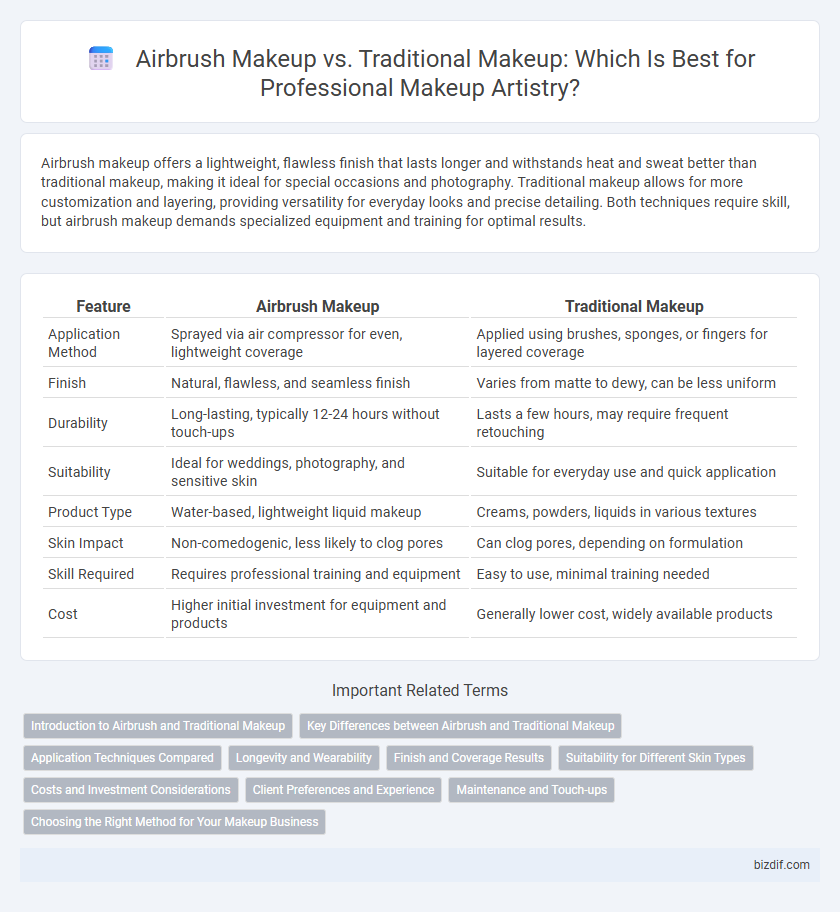Airbrush makeup offers a lightweight, flawless finish that lasts longer and withstands heat and sweat better than traditional makeup, making it ideal for special occasions and photography. Traditional makeup allows for more customization and layering, providing versatility for everyday looks and precise detailing. Both techniques require skill, but airbrush makeup demands specialized equipment and training for optimal results.
Table of Comparison
| Feature | Airbrush Makeup | Traditional Makeup |
|---|---|---|
| Application Method | Sprayed via air compressor for even, lightweight coverage | Applied using brushes, sponges, or fingers for layered coverage |
| Finish | Natural, flawless, and seamless finish | Varies from matte to dewy, can be less uniform |
| Durability | Long-lasting, typically 12-24 hours without touch-ups | Lasts a few hours, may require frequent retouching |
| Suitability | Ideal for weddings, photography, and sensitive skin | Suitable for everyday use and quick application |
| Product Type | Water-based, lightweight liquid makeup | Creams, powders, liquids in various textures |
| Skin Impact | Non-comedogenic, less likely to clog pores | Can clog pores, depending on formulation |
| Skill Required | Requires professional training and equipment | Easy to use, minimal training needed |
| Cost | Higher initial investment for equipment and products | Generally lower cost, widely available products |
Introduction to Airbrush and Traditional Makeup
Airbrush makeup uses a specialized air compressor to spray a fine mist of foundation, providing a lightweight, flawless, and long-lasting finish ideal for high-definition photography and special events. Traditional makeup involves applying products with brushes, sponges, or fingers, offering versatility and ease of touch-ups throughout the day. Airbrush techniques deliver a smoother, more even coverage compared to traditional methods, which may leave visible brush strokes or heavier buildup.
Key Differences between Airbrush and Traditional Makeup
Airbrush makeup utilizes a specialized air compressor to spray a fine mist of makeup, offering a lightweight, flawless finish with superior blending and longer-lasting wear compared to traditional makeup applied with brushes or sponges. Traditional makeup often involves thicker layers and more frequent touch-ups, whereas airbrush techniques provide a more natural, even coverage ideal for high-definition photography and events. Airbrush makeup is typically more hygienic due to less product contact with tools and skin, reducing the risk of contamination.
Application Techniques Compared
Airbrush makeup uses a fine, pressurized spray to deliver a lightweight, even layer of foundation, allowing for precise control and a flawless finish ideal for high-definition settings. Traditional makeup application involves brushes, sponges, or fingers, which can vary in coverage and may require multiple layers to achieve similar results. Airbrush techniques offer faster drying times and longer wear, while traditional methods provide more versatility for detailed contouring and blending.
Longevity and Wearability
Airbrush makeup provides superior longevity and wearability compared to traditional makeup, often lasting up to 12-16 hours without fading or smudging. Its fine mist application ensures even coverage and a lightweight feel, making it ideal for long events like weddings and photo shoots. Traditional makeup may require frequent touch-ups due to its thicker texture and susceptibility to sweating and oil breakdown.
Finish and Coverage Results
Airbrush makeup delivers a flawless, lightweight finish with seamless blending that enhances natural skin texture, providing long-lasting, buildable coverage ideal for high-definition photography. Traditional makeup offers more customizable coverage options, ranging from sheer to full, but can sometimes appear heavier or cakey if over-applied, making it less effective for achieving a smooth, airbrushed effect. Both techniques cater to different skin types and occasions, with airbrush makeup favored for its durability and polished look, while traditional makeup allows for more hands-on contouring and correction.
Suitability for Different Skin Types
Airbrush makeup provides a lightweight, breathable finish ideal for oily and acne-prone skin, as its fine mist application minimizes clogging pores. Traditional makeup offers versatile layering options suitable for dry and combination skin, allowing customized hydration and coverage. Choosing between airbrush and traditional techniques depends on skin type sensitivity and desired finish for optimal wearability.
Costs and Investment Considerations
Airbrush makeup typically requires a higher initial investment due to the cost of specialized equipment and maintenance, often ranging from $300 to $800 for a quality airbrush system. Traditional makeup tools and products usually have a lower upfront cost but may require more frequent purchases, potentially increasing long-term expenses. Consideration of client volume, desired finish, and durability should guide investment decisions between airbrush and traditional makeup artistry.
Client Preferences and Experience
Airbrush makeup offers a lightweight, long-lasting finish that appeals to clients seeking a natural yet flawless look, often preferred for weddings and photo shoots due to its durability and high-definition results. Traditional makeup allows for more texture variation and immediate touch-ups, giving clients a flexible experience with tangible product application. Client preferences tend to lean towards airbrush makeup for special events, while traditional makeup remains favored for everyday wear and those who enjoy a hands-on approach.
Maintenance and Touch-ups
Airbrush makeup offers a longer-lasting finish with minimal need for touch-ups due to its fine atomization and lightweight formula that adheres better to the skin. Traditional makeup requires more frequent maintenance and blending throughout the day, especially in areas prone to oiliness or sweat. Professional airbrush kits often include specialized cleaning solutions to ensure the equipment remains in optimal condition, whereas traditional brushes and sponges must be washed regularly to prevent product buildup and skin irritation.
Choosing the Right Method for Your Makeup Business
Choosing between airbrush makeup and traditional makeup hinges on client needs and business goals; airbrush offers a lightweight, long-lasting finish ideal for bridal and high-definition events, while traditional makeup provides versatility for creative and theatrical looks. Investing in airbrush technology can differentiate your makeup business by delivering flawless, photo-ready results with quicker application times, but traditional methods remain essential for detailed contouring and bold color work. Balancing both techniques enhances service offerings, attracting a broader clientele and boosting overall client satisfaction.
Airbrush makeup vs Traditional makeup Infographic

 bizdif.com
bizdif.com